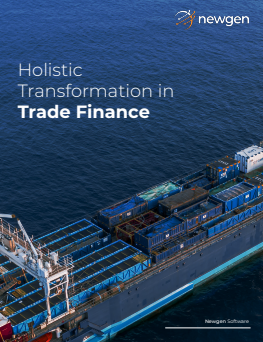Why Trade Finance Needs Urgent Modernization?
Trade finance is the lifeblood of global commerce, powering 80–90% of cross-border trade and supporting a $5.2 trillion ecosystem. Yet despite its scale and importance, the sector remains heavily paper-driven, complex, and fragmented. Banks and financial institutions find themselves constrained by outdated systems, rising compliance costs, and slow, error-prone operations, all while demand for trade financing continues to grow.
According to the Asian Development Bank, the global trade finance gap hit $1.7 trillion in 2020, representing 10% of global trade. This is not due to lack of demand but rather the inability of existing systems to process and manage trade transactions efficiently and safely.
Modernizing trade finance is not optional; it is a strategic imperative for banks to remain competitive, reduce operational burden, and tap into a massive untapped market.
What Holds Banks Back?
Trade finance transactions are inherently complex, often involving 15-20 participants from exporters and importers to banks, port authorities, customs, freight forwarders, insurers, and regulators. Over time, banks have built fragmented, legacy infrastructures that make transformation difficult:
- Disconnected operations and systems – multiple platforms duplicating work and creating data silos
- Manual, paper-heavy workflows- time-consuming document processing and approvals
- Rigid legacy architectures- slow to integrate with modern digital solutions
- Ever-changing compliance demands- KYC, AML, sanctions, and global regulations add complexity and risk
- Integration challenges- complex connectivity needed across internal and external networks
- Failed past modernization attempts- many banks have tried partial digitization with limited impact
The result is an expensive, error-prone, and slow trade finance process that struggles to keep up with digital-first competitors and new regulations.
The Four-Pronged Approach to Trade Finance Transformation
True modernization requires more than front-end upgrades; it calls for a holistic, platform-driven strategy built on four core pillars:
1. Orchestrate End-to-End Customer Journeys
Move beyond siloed workflows to intelligent process orchestration:
- Automate the entire trade lifecycle, from origination to settlement.
- Use omnichannel engagement (web, mobile, SWIFT, email, branch) for seamless customer interaction.
- Balance straight-through processing (STP) for routine transactions with expert intervention for complex cases using smart triaging.
2. Digitize Content for Speed and Accuracy
Trade finance is document-heavy. Digitization reduces friction by:
- Converting paper into digital, structured content.
- Using AI-based document analytics for data extraction, validation, and correction.
- Automating document checks against ICC/UCP/UCC guidelines to reduce manual review time.
3. Integrate for Straight-Through Processing
Break silos by connecting core trade finance systems with internal applications and external stakeholders:
- Seamless data sharing across risk, compliance, credit, and settlement systems.
- Real-time integration with partner networks (customs, shipping, ports, freight, regulators).
- Fraud, AML, and sanctions screening embedded into workflows for compliance and speed.
4. Accelerate With Low-Code Agility
Speed matters in trade. Low-code platforms enable:
- Rapid application development and deployment for new products and processes.
- Easy configuration and updates to adapt to new regulations or market changes.
- Greater flexibility and faster ROI without disrupting ongoing operations.
Technology-Driven Trade Finance: The Future State
A unified, low-code trade finance platform makes it possible to:
- Enable omnichannel origination so customers can initiate transactions anywhere.
- Auto-ingest and process structured and unstructured content with real-time data extraction.
- Perform AI-powered risk profiling and compliance checks with customizable business rules.
- Support automated exceptions and escalation handling for deviations.
- Track every instrument digitally from submission to closure with dashboards and alerts.
- Enable secure collaboration across internal teams and external partners.
This approach reduces manual work, speeds up transactions, strengthens compliance, and improves the overall customer experience.
Why Low-Code Is a Game-Changer?
Traditional modernization is risky and long-winded. A low-code digital platform offers an agile, safe alternative by allowing banks to:
- Build new digital trade finance capabilities incrementally while keeping current operations running.
- Reuse models and components for rapid rollout across geographies and product lines.
- Keep control of compliance while adapting to local and global regulations.
- Reduce cost and time-to-market by avoiding full rip-and-replace of legacy systems.
The Newgen Advantage
Newgen’s Trade Finance Platform, built on the AI-first NewgenONE low-code platform, enables banks to transform trade finance holistically with:
- Intelligent Process Automation: fully digitize and automate complex workflows.
- Contextual Content Services: capture, classify, and manage trade documents with analytics.
- Omnichannel Customer Engagement: deliver consistent, secure, and real-time communication across channels.
- Seamless Integrations: connect internal and external trade ecosystems effortlessly.
- Governance and Compliance Readiness: full audit trails, automated policy enforcement, and real-time monitoring.
Banks using Newgen have reported faster transaction cycles, reduced compliance risk, lower operational costs, and greater agility to launch new trade products.
Benefits at a Glance
- 50% faster transaction processing with straight-through automation
- 30% reduction in compliance workload with integrated checks and risk profiling
- Improved customer experience through seamless, end-to-end digital journeys
- Cost savings and higher ROI by reusing low-code components and reducing manual effort
- Future-proof scalability to adapt to evolving regulations and market conditions
Why Acting Now Is Critical?
Global trade is recovering, but competition and complexity are rising. Fintech players and alternative platforms are moving fast with digital-first solutions. Regulatory scrutiny is increasing, and customers expect real-time transparency and faster processing.
Banks that modernize their trade finance operations holistically will secure competitive advantage, reduce operational risk, and open new revenue opportunities. Those who wait risk being left behind.
Start Your Trade Finance Transformation
If your trade finance function is still dependent on manual processes, fragmented systems, and slow compliance checks, now is the time to modernize.

